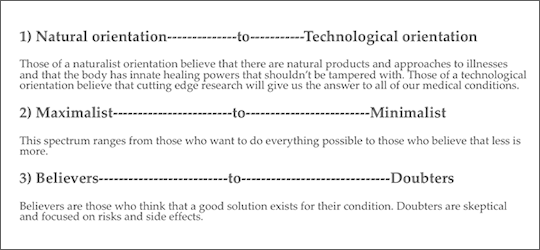
This post was contributed by
Cindi Gatton, Pathfinder Patient Advocacy Group
As professional patient advocates we come to our discipline with a deep desire to help people through the vagaries of our healthcare system, a system that can swallow up even the most informed consumer. Our clients trust us to be able to step back from the situations that are upsetting and unfathomable to them to help them make truly personalized, informed decisions.
This is not work for the weak of heart. In so doing we pledge to amplify our client’s voices, but not become it. This would seem to be easy, but in effect, it can be harder than we might think.
Every individual has a filter through which they process their healthcare values. Perhaps one of the most important things we have to do as advocates is to become conscious about these filters, first our own, and then our clients.
To facilitate that, I’ve used a tool that comes from the book by Jerome Groopman and Pamela Hartzband, Your Medical Mind. How to Decide What is Right for You. New York : Penguin Press, 2011. They describe 3 scales of how we perceive healthcare.
Here’s the graphic:

Taking the time to do a personal inventory before you ever open the doors to your practice is critical. Some advocates may choose to focus their practice solely along their own value orientation. But if you don’t do this, it may even be useful to review your orientation as part of an annual business assessment, because just as our clients may move along these continuums, so might we.
Whether you formally, or informally assess your clients along these continuums is equally important. If, for example, you find yourself to be strongly in favor of a more natural orientation for yourself, in what ways could that influence your research and presentation for a client who is more technologically oriented?
In my own practice, I pay special attention to whenever I feel the word “should” making its way to my lips. While I can’t take credit for it, the notion of “should-ing” on someone is an indicator that my own values have slipped in front of my client’s. Being conscious of my own preferences in healthcare decision-making has given me an understanding of what might be at the root of my feeling the urge to “should” on someone. It usually comes from the tension between my sense of what would be right for me, and some level of dissonance with a client or family member’s preferences.
Perhaps one of the most challenging situations we can face as professional advocates is being engaged with a client who makes a decision that we feel may not be in their best interest. But the operative word there is “best.” Best isn’t quantitative; it’s qualitative. If we’ve done our jobs right, our clients will make decisions that align with what they feel is best for them and we may have been given the privilege of helping them consciously articulate that.
This is how we help our clients reach truly informed decisions. And if you’re consciously aware of what’s best for you, understanding that it has nothing to do with what’s best for your client, you will find it much less stressful when a client’s decision doesn’t align with yours.
If you’d like to better understand this scale, clarify your own values, or discuss a case where differences may be impacting you or a client, your APHA mentors stand ready to assist.
Return to the Master List of Health & Patient Advocate Educational Programs
SEP
2018
